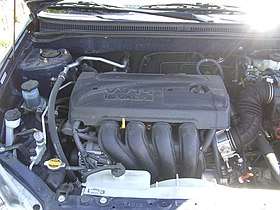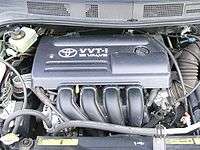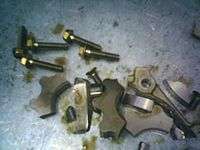Toyota ZZ engine
The Toyota ZZ engine family is a straight-4 piston engine series. The ZZ series uses a die-cast aluminum engine block with thin press-fit cast iron cylinder liners, and aluminum DOHC 4-valve cylinder heads.[1] The camshafts are chain-driven. The two 1.8 L members of the family, the 1ZZ and 2ZZ, use different bore and stroke. The former was optimized for economy, with torque emphasized in lower revolutions per minute operating range, while the latter is a "square" design optimized for high-RPM torque, yielding higher peak power. The ZZ family replaced the extremely popular cast-iron block 4A engines.
| Toyota ZZ engine | |
|---|---|
 2005 Toyota Corolla S engine | |
| Overview | |
| Manufacturer | Toyota |
| Production | 1997-present |
| Layout | |
| Configuration | Straight-4 |
| Displacement | 1.4 L; 85.3 cu in (1,398 cc) 1.6 L; 97.5 cu in (1,598 cc) 1.8 L; 109.5 cu in (1,794 cc) 1.8 L; 109.6 cu in (1,796 cc) |
| Cylinder bore | 79 mm (3.11 in) 82 mm (3.23 in) |
| Piston stroke | 71.3 mm (2.81 in) 81.5 mm (3.21 in) 85 mm (3.35 in) 91.5 mm (3.60 in) |
| Block material | Aluminium, Cast iron |
| Head material | Aluminium |
| Valvetrain | DOHC 4 valves x cyl. with VVT-i and VVTL-i (some versions) |
| Compression ratio | 10.0:1, 11.5:1 |
| Combustion | |
| Supercharger | TRD (some versions) |
| Fuel system | Multi-point fuel injection |
| Fuel type | Gasoline |
| Cooling system | Water-cooled |
| Chronology | |
| Predecessor | A engine |
| Successor | ZR engine (for 1ZZ and 2ZZ series) |
Toyota engine names are interpreted as follows. The leading number denotes the generation, and the next one or two letters, followed by a hyphen, specify the engine family. The remaining letters, following the hyphen, describe the engine's major features. For example, the 2ZZ-GE can be decoded as being the second generation of the ZZ engine series and features a performance-oriented cylinder head with widely angled valves (G) and electronic fuel injection (E).[2] See also: Toyota engines and how to read their names.
1ZZ
1ZZ-FE

The 1ZZ-FE is a 1.8 L (1,794 cc) version built in Buffalo, West Virginia. Its production in Cambridge, Ontario was discontinued in December 2007. Bore X stroke of 79 mm × 91.5 mm (3.11 in × 3.60 in). Compression ratio is 10.0:1. Output is between 120 bhp (122 PS; 89 kW) at 5,600 rpm with 122 lbf⋅ft (165 N⋅m) of torque at 4,400 rpm, 130 bhp (132 PS; 97 kW) at 6,400 rpm with 126 lbf⋅ft (171 N⋅m) of torque at 4,200 rpm. It uses MPFI, has VVT-i (1998-99 1ZZ engines don't have VVT-i), and features fracture-split forged powder metal connecting rods, one-piece cast camshafts, and either a cast aluminum intake manifold or a molded plastic intake manifold.[3][4]
A factory supported bolt-on supercharger kit was sold for the 2003–2004 Corolla and Matrix by Toyota Racing Development, and Pontiac Vibe by GM Performance. The supercharger gives 7.5lbs of boost, with a 40 horsepower and 38ft-lbs of torque increase at the wheels. [5]
Applications:
- Toyota Corolla CE/LE/S/VE, Fielder, Runx (Japan), Altis (Asia)
- Toyota Corolla Verso
- Toyota Allion
- Toyota Premio
- Toyota Vista and Vista Ardeo
- WiLL VS
- Toyota Caldina
- Toyota RAV4
- Chevrolet Prizm
- Pontiac Vibe
- Toyota Celica GT
- Toyota Matrix
- Toyota Avensis
- Toyota Opa
- Toyota Isis
- Toyota Wish
- Lotus Elise
Toyota announced a voluntary recall of 2005 to 2008 Toyota Corollas and Matrixes equipped with 1ZZ-FE engines. The issue involves the engine control module, and includes the potential for it to develop a crack on the module's circuit board, which can result in the car not starting, the transmission shifting harshly, or the engine stalling. Additionally, Pontiac announced a voluntary recall of Pontiac Vibes from years 2005 to 2008 for the same issue.
1ZZ-FED
The 1ZZ-FED is similar to the 1ZZ-FE but is built separately in the Shimoyama plant. Toyota's advertised power output is 140 bhp (142 PS; 104 kW) at 6,400 rpm and 127 lb⋅ft (172 N⋅m) of torque at 4,400 rpm. Additional power output over the 1ZZ-FE is accomplished by larger valves and corresponding revisions to the ports. It uses Multi-point fuel injection, VVT-i[6] and has larger 32mm intake valves and 27.5mm exhaust valves compared to the 2002-2008 1ZZ-FE.
Applications:
- Toyota Celica GT
- Toyota MR2 Spyder
- Toyota Wish 1.8
- WiLL VS 1.8
1ZZ-FBE
Special modified 1ZZ-FE that can run on E100 Ethanol.
Applications:
- Toyota Corolla (Brazil only)
2ZZ
2ZZ-GE

The 2ZZ-GE is a 1.8 L; 109.6 cu in (1,796 cc) version built in Japan. Bore x stroke is 82 mm × 85 mm (3.23 in × 3.35 in). It uses Multi-point Fuel Injection, VVTL-i, and features forged steel connecting rods. Compression ratio is 11.5:1, necessitating "premium" gasoline (91 octane or above in the (R+M)/2 scale used in North America[8]). Power output for this engine varies depending on the vehicle and tuning, with the Celica GT-S, Corolla T-Sport,[9][10] Lotus Elise and Lotus Exige offering 141 kW (189 hp), whereas the American versions of the 2003 Matrix and Pontiac Vibe versions produce 180 hp (134 kW) @ 7,600 rpm[8] and 130 lb⋅ft (176 N⋅m) @ 6800 rpm, with all later years offering anywhere from 173 hp (129 kW) in 2004 to 164 hp (122 kW) in 2006 due to a recurved powerband. The differing power figures from 2004 through 2006 are due to changes in dynamometer testing procedures. The Australian variant Corolla Sportivo produces 141 kW (189 hp) at 7,600 rpm and 181 N⋅m (133 lbf⋅ft) of torque. Due to noise regulations, Toyota recalled them for a flash of the PCM to up their output to classify them in the more lenient "sports car" noise category. The Corolla Compressor and Lotus Exige S add a supercharger with intercooler to achieve 225 hp (168 kW), while the Exige 240R's supercharger increases output to 240 hp (179 kW). The addition of a non-intercooled supercharger to the Elise SC produces 218 hp (163 kW) with a considerable weight saving. The supercharged engines are not labeled 2ZZ-GZE.
Unique to the ZZ family, the 2ZZ-GE utilizes a dual camshaft profile system (the "L" in VVTL-i, known by enthusiasts and engineers alike as "lift" similar to Hondas VTEC) to produce the added power without an increase in displacement or forced induction. The 2ZZ-GE was the first production engine to combine cam-phasing variable valve timing with dual-profile variable valve lift in the American market. The table below lists the specifications of the two camshaft profiles.
| Intake | Exhaust | |||
|---|---|---|---|---|
| Duration | Valve lift | Duration | Valve lift | |
| Low Cam | 228° | 7.6 mm (0.30 in) | 228° | 7.6 mm (0.30 in) |
| High Cam | 292° | 11.2 mm (0.44 in) | 276° | 10 mm (0.39 in) |
Toyota commissioned Yamaha to design the 2ZZ-GE, based on Toyota's ZZ block, for high-RPM operation and producing a power peak near the top of the RPM range. The high-output cam profile is not activated until approximately 6,200 rpm, (lift set-points are between 6,000–6,700 rpm depending on the vehicle) and will not engage until the engine has reached at least 60 °C (140 °F). The Toyota PCM electronically limits RPM to about 8,200 RPM via fuel and/or spark cut. The "lift" engagement and the engine redline vary by application. Lotus 2ZZ-GEs are rev limited to 8,500 RPM, for example, whereas Celicas were rev limited to 7,900 to 8,200 RPM in North America, depending on the model year. The first Japanese versions were rev limited to 8,600 rpm with a peak of 190 hp (142 kW). Consequently, it is impossible to "over-rev" the engine with the throttle alone; a downshift from a higher gear must be involved. A typical "over-rev" can damage the oil pump, commonly disintegrating the lobe ring, resulting in damage similar to the picture at right. The oil pump is the Achilles heel of the 2ZZ, though incidents are rare and usually occur due to fault of the driver. Even the briefest period of oil starvation is usually fatal to this engine design.
The high pressure cast aluminum alloy engine block had Metal Matrix Composite (MMC) reinforced cylinder walls. MMC is a reinforcement material composed of ceramic parts and fibers.
For the first few years of production, the engines were notorious for failing "lift bolts". This did not damage the engine, but would hamper performance as the high output cam profile was unable to properly engage. Toyota fixed the problem in late 2002 with a redesigned bolt that was installed on later engines. Earlier engines with the problematic bolts can be fixed via a Toyota-issued TSB simply requiring the new bolt to be installed in place of the old one.
The 2004 and newer Matrix and Corolla XRS models were equipped with smog pumps and have an extra hole above each exhaust port in the engine head and manifold where air is injected to achieve complete fuel burning before the exhaust stream reaches the catalyst. All 2ZZ-GE heads from 03/03 onwards carry this modification even if the vehicle does not have the air injection system.
Applications:
- Toyota Celica SS-II (Japan, 190 PS (140 kW; 187 hp))
- Toyota Celica GT-S (USA, 180 hp (134 kW; 182 PS))
- Toyota Celica 190/T-Sport (UK, 189 hp (141 kW; 192 PS))
- Toyota Celica SX (Australia, 189 hp (141 kW; 192 PS)/180 N⋅m (133 lbf⋅ft))
- Toyota Celica ZR (Australia, 189 hp (141 kW; 192 PS)/180 N⋅m (133 lbf⋅ft))
- Toyota Corolla Sportivo (Australia, 189 hp (141 kW; 192 PS)/180 N⋅m (133 lbf⋅ft))
- Toyota Celica TS (Europe, 189 hp (141 kW; 192 PS))
- Toyota Corolla Compressor (Europe, supercharged, 225 PS (165 kW; 222 hp))
- Toyota Corolla XRS (USA, 164 / 170 hp (122 / 127 kW; 166 / 172 PS))
- Toyota Corolla Fielder Z Aero Tourer (Japan, 190 PS (140 kW; 187 hp))
- Toyota Corolla "Runx Z Aero Tourer" (Japan, 190 PS (140 kW; 187 hp))
- Toyota Corolla RunX RSi (South Africa, 141 kW (192 PS; 189 hp)/180 N⋅m (133 lbf⋅ft))
- Toyota Matrix XRS (USA, 164–180 hp (122–134 kW; 166–182 PS))[8]
- Pontiac Vibe GT (USA, 164–180 hp (122–134 kW; 166–182 PS))
- Toyota Voltz Z (Japan, 180 hp (134 kW; 182 PS))
- WiLL VS 1.8
- Lotus Elise (North America/UK, 190 hp (142 kW; 193 PS))[11]
- Lotus Exige (US/UK, 190 hp NA & 243 hp supercharged)[12][13]
- Lotus Exige CUP 260 (US/UK, supercharged, 260 PS (191 kW; 256 hp))
- Lotus 2-Eleven (US/UK, supercharged, 252 hp (188 kW; 255 PS))
3ZZ
3ZZ-FE
The 3ZZ-FE is a 1.6 L (1,598 cc) engine unit built in Japan. It is found in the Toyota Corolla Altis which is sold in Asian countries such as Singapore, Malaysia, Philippines, Thailand, Pakistan (as SE Saloon) and Taiwan; and in the Toyota Corolla sedan sold in Sri Lanka. In South Africa, the motor can be found in the RunX 160 and Corolla 160.
The entire exterior design and chassis is the same as the American Corolla. Bore and stroke is 79 mm × 81.5 mm (3.11 in × 3.21 in). Max. output is 109 hp (81 kW; 111 PS) at 6,000 rpm. Max. torque is 150 N⋅m (111 lb⋅ft) at 3,800 rpm. Features SMP pistons v/s Toyota made in 1ZZ-FE engine. The preferred engine oil is 5W30 API grade SL/SM.
Applications:
- Toyota Corolla (Europe & Middle East, 109 hp (81 kW; 111 PS))
- Toyota Corolla Altis (Asian, 110 hp (82 kW; 112 PS))
- Toyota Corolla RunX 160 (South African, 108 hp (81 kW; 109 PS) @ 6000 and 146 Nm @ 4400)
- Toyota Corolla XLi (Brazil, 110 hp (82 kW; 112 PS))
- Toyota Avensis (Europe, 109 hp (81 kW; 111 PS))
4ZZ
4ZZ-FE
The 4ZZ-FE is a 1,398 cc (1.4 L; 85.3 cu in) version. Bore and stroke is 79 mm × 71.3 mm (3.11 in × 2.81 in). Output is 97 hp (72 kW; 98 PS) at 6000 rpm with 130 N⋅m (96 lb⋅ft) of torque at 4400 rpm.
Applications:
- Toyota Corolla
- Toyota Auris
- Toyota RunX 140
References
- "Toyota engines". Toyoland.com. Retrieved 2012-11-23.
- http://toyotacelicaonline.com/engine.htm Toyota Celica Online - Engine Number
- http://papers.sae.org/981087/
- http://www.spyderchat.com/1zzfe.pdf 1ZZ-FE SAE technical paper from Toyota
- https://www.caranddriver.com/news/a15133815/supercharged-trd-matrix-auto-shows/
- "2002 Toyota MR2, 2005 MY ZZW30". carfolio.com. February 28, 2013. Retrieved July 26, 2018.
- https://www.twoeggz.com/news/4431285.html
- "The Next Band Wagons" - Motor Trend, Chris Walton. May 2002
- http://www.zeperfs.com/en/fiche367-toyota-corolla-ts.htm
- https://web.archive.org/web/20050509154910/http://motor.terra.es/motor/contactos/c_ficha.cfm?id=MOT21278
- "Lotus Elise R - Vehicle Description". Group Lotus PLC. Archived from the original on May 17, 2008. Retrieved 2008-06-24.
- Chris Walton (2006-06-28). "Full Test: 2006 Lotus Exige". Edmunds Inc. Archived from the original on 2008-06-25. Retrieved 2008-06-24.
- Greg N. Brown. "Newcomers: 2007 Lotus Exige S". MotorTrend. Source Interlink Media, Inc. Retrieved 2008-06-24.
External links
| Wikimedia Commons has media related to Toyota ZZ engines. |